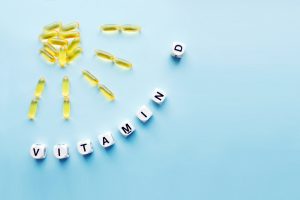Published on October 22, 2021
From cancer to COVID and many other diseases, taking certain steps with vitamin D can be a determining factor for whether you are more likely to have a good or bad outcome.
Key Points
- “How much vitamin D should I take?” The answer: It depends on your current vitamin D level! Test first, then determine how much to take to get to 40-60 ng/ml (100-150 nmol/L) or another target appropriate for your health concerns
- It is vital to TEST, ADJUST, RE-TEST and REPEAT to make sure that your daily dose or vitamin D routine is effective at achieving and maintaining your desired target vitamin D level. These steps can be easily followed when participating in the D*action project, while contributing your data to research as a citizen scientist.
The knowledge surrounding vitamin D and its many health benefits has increased over the last several decades, with thousands of research papers already published to demonstrate its multiple effects. What are some of the most important things we have known, and some of the things we have recently discovered, about vitamin D?
In part 2 of the video below, Dr. Cedric Garland, Principle Investigator of the vitamin D*action study, discusses initial findings from the project and the importance of participation for yourself and for the research.
Video Highlights
Here are some key points covered in the video:
- Even in a very “health-aware” population, in the D*action study, approximately 51% did not get enough vitamin D (below 40 ng/ml or 100 nmol/L)
- This study has demonstrated the efficiency and safety of higher vitamin D levels and intake, with nearly 50% having a level of at least 40 ng/ml and a dose to maintain that level
- D*action presents a new opportunity to observe how each individual responds to vitamin D supplementation, and is a powerful tool to understanding the effects of self-selected higher levels of vitamin D
- “How much vitamin D should I take?” The answer: It depends on your current vitamin D level! Test first, then determine how much to take to get to 40-60 ng/ml (100-150 nmol/L) or another target appropriate for your health concerns
- There is an increase of approximately 7-10 ng/ml with each 1000 IU/day (this is more relevant to lower levels of vitamin D, as the dose response curve begins to plateau… which we discovered with more participants involved!)
- D*action has also provided a better understanding about how sun exposure affects vitamin D levels – most need more than 5-10 min sun exposure per day, which is safe if you don’t burn!
- Should cancer patients take vitamin D? YES! In fact, cancer patients and those hoping to avoid cancer may want to aim for a vitamin D level of 60 ng/ml or higher
- Individuals with granulomatous diseases, TB, sarcoidosis may need to be more cautious about their vitamin D intake
- Should you be tested for vitamin D? Absolutely! Establish a baseline first (to know what you get on a normal day to day basis from sun and food), then test each February/March and August/September to find out what your annual vitamin D low and high is
- Take Action Now! Join D*action…
Use What You Know About Vitamin D to Make a Measurable Difference – Join D*action!
 Have you taken this increased knowledge and translated it into action for your own health? Are you confident that you are getting enough vitamin D to maintain your target level?
Have you taken this increased knowledge and translated it into action for your own health? Are you confident that you are getting enough vitamin D to maintain your target level?
Everyone responds differently to vitamin D, so that the same dose of vitamin D is likely to result in different vitamin D levels from one person to the next. There are certain steps that are essential to ensuring you have found the right dose of vitamin D and/or the right routine for the level you are trying to achieve.
Discover Your Best Dose of Vitamin D by Following these Simple Steps
- Enroll and test to find your current vitamin D level
- Complete your online questionnaire as part of the D*action project
- Determine the target level you want to aim for. Our scientists recommend a level between 40-60 ng/ml (100-150 nmol/L), however, some research indicates levels over 60 ng/ml may be beneficial for certain conditions such as autoimmune diseases and cancer.
- Calculate a suggested vitamin D intake based on your current level, target level, and weight using the vitamin D*calculator. Consider a loading dose as needed.
- Implement your new vitamin D supplement dose and/or routine (will you include sunshine or an indoor UVB device, increase vitamin D rich foods, etc.?)
- Re-test your levels to see how your vitamin D routine is working (this step is VITAL!). Adjust your vitamin D intake again if needed, or consider evaluating vitamin D co-nutrients or other factors if you did not achieve the result you expected. Re-test after 3-6 months or sooner if using a loading dose.
- Repeat until you have reached your target! Experts suggest testing a minimum of twice each year to make sure target levels are maintained, as levels tend to be highest at the end of summer and lowest at the end of winter.
In Conclusion
Supplementation does not always provide the expected change in vitamin D level. It is vital to TEST, ADJUST, RE-TEST and REPEAT to make sure that the daily dose or vitamin D routine is effective at achieving and maintaining the desired target vitamin D level. For example, an analysis of 5,442 GrassrootsHealth participants who completed at least two vitamin D tests showed that two-thirds (67%) reached a vitamin D level of at least 40 ng/ml on their second test – leaving 1/3 of those who re-tested still below the 40 ng/ml target level.
Keeping Up with Your Vitamin D is an Essential Part of Staying Healthy
 Having and maintaining healthy vitamin D levels and other nutrient levels can help improve your health now and for your future. Choose which to measure, such as your vitamin D, omega-3s, and essential minerals including magnesium and zinc, by creating your custom home test kit today. Take steps to improve the status of each of these measurements to benefit your overall health. You can also track your own intakes, symptoms and results to see what works best for YOU.
Having and maintaining healthy vitamin D levels and other nutrient levels can help improve your health now and for your future. Choose which to measure, such as your vitamin D, omega-3s, and essential minerals including magnesium and zinc, by creating your custom home test kit today. Take steps to improve the status of each of these measurements to benefit your overall health. You can also track your own intakes, symptoms and results to see what works best for YOU.
Enroll and test your levels today, learn what steps to take to improve your status of vitamin D (see below) and other nutrients and blood markers, and take action! By enrolling in the GrassrootsHealth projects, you are not only contributing valuable information to everyone, you are also gaining knowledge about how you could improve your own health through measuring and tracking your nutrient status, and educating yourself on how to improve it.
Help everyone Move Research into Practice with vitamin D and other nutrients! As a special birthday gift to everyone, in honor of the science, we have created a special scholarship fund for anyone to donate to that will go towards helping others participate. Your donation will allow anyone to get help with funding their participation when they need it.
Text-to-give: Text Daction to 44321 to add to our Scholarship Fund.


 Watch the Video Now
Watch the Video Now


